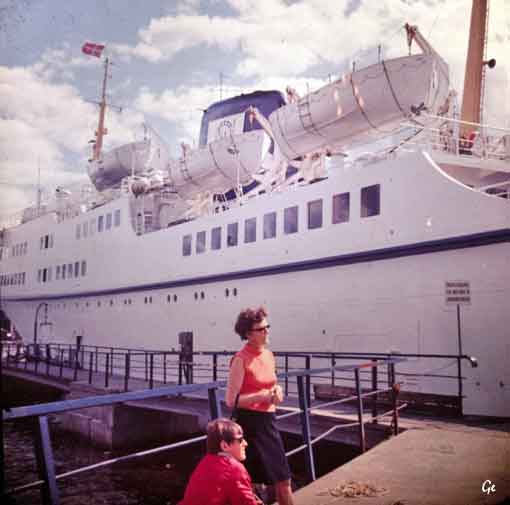
Klar til å gå ombord på Holger Danske.
Bussen vår gikk fra Fredericia i Danmark.
MS «Holger Danske» var et norsk skip som trafikkerte ruten
Oslo– Århus med rederiet DA-NO Linjen fra 1961 til 1974.
Fra 1974 til 1989 seilte hun ruten Oslo–Fredrikshavn.
I 1989 ble hun solgt til Ross Sea Shipping Ltd, Gibraltar, og
benyttet som flyktningskip/pilegrimsferge.
https://no.wikipedia.org/wiki/MS_%C2%ABHolger_Danske%C2%BB
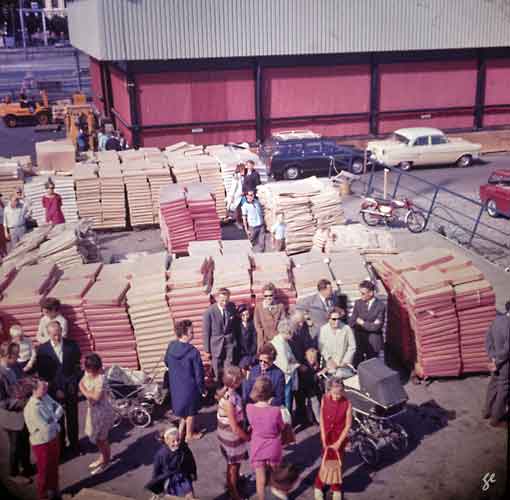
Onkel Leif, tante Ellen og kusinene
Kirsten og Lene var møtt opp for å vinke farvel.
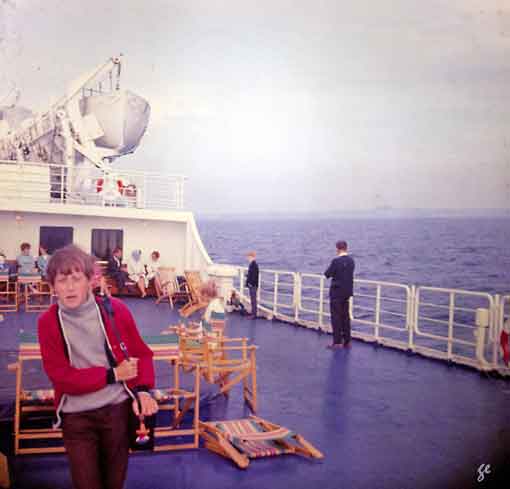
Holger Danske gikk under tilnavnet "Holder Kanskje"
Det skulle ikke mye sjø til før det ble ubehagelig.
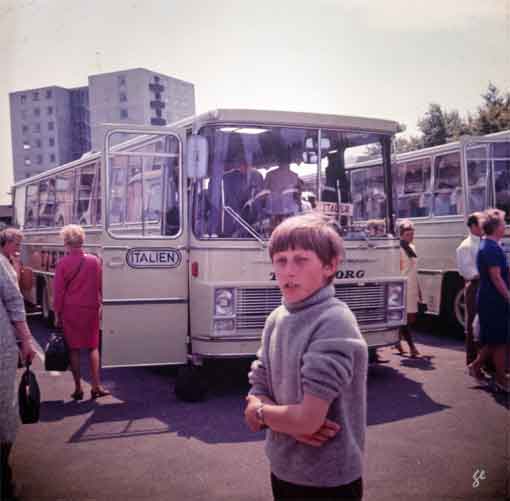
Vi er framme i Fredericia og bussen står klar.
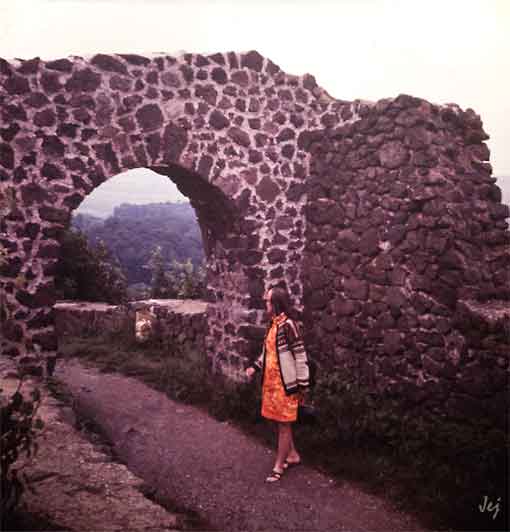
Burg Heiligenberg i Tyskland
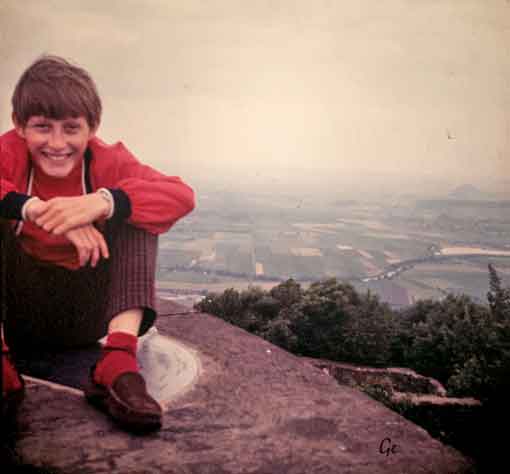
Det er fin utsikt fra Burg Heiligenberg. Synd det er så disig.
on the hill of Heiligenberg in the district of Schwalm-Eder-Kreis,
Hesse, Germany.
Heilgenberg is a 393 m (1,289 ft) high hill close to the town of
Felsberg-Gensungen in North Hesse. The hill is the remains of an extinct Miocene volcano, of which only the basalt that filled the
neck of the volcano remains.
The name of the hill stems from
one of the oldest churches in Hesse.
Extensive views of the surrounding area can be seen from the ramparts of the ruins, and so that it is a local tourist
attraction. The entrance to the ruined castle and tower is free.
Heiligenburg Castle - Wikipedia (17. juni 2022)
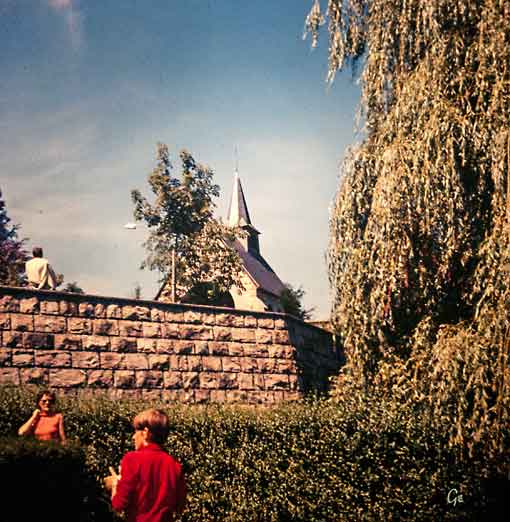
Vi er ved Vierwaldstättersjøen i Sveits.
Her er det et minnesmerke for prinsesse Astrid av Sverige,
senere dronning Astrid av Belgia.
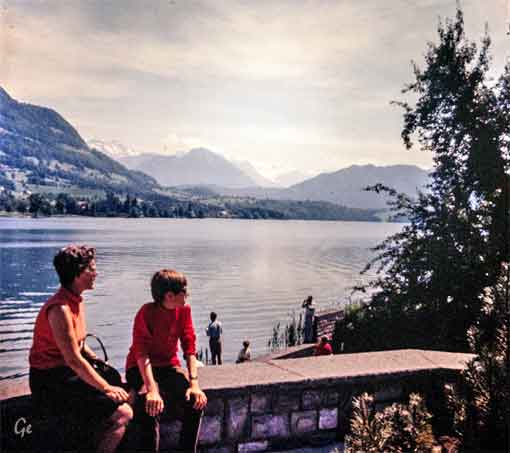
Astrid av Belgia (Astrid Sofia Lovisa Thyra)
(født 17. november 1905 på Arvfurstens slott i Stockholm,
død 29. august 1935 i Küßnacht, Sveits) var dronning av Belgia 1934–1935.
Hun ble født som Hennes Kongelige Høyhet Prinsesse Astrid av
Sverige. Hun var den yngste datteren av prins Carl av Sverige og prinsesse Ingeborg av Danmark, og lillesøsteren til prinsesse
Märtha, som senere ble kronprinsesse av Norge.
Sensommeren 1935 var nemlig kongeparet på biltur i Sveits, og
ved et uhell kjørte de av veien og inn i et pæretre. Kong Leopold
klarte seg godt med bare noen skrammer, mens dronning Astrid
døde i sin ektemanns armer, bare 29 år gammel.
https://no.wikipedia.org/wiki/Astrid_av_Sverige
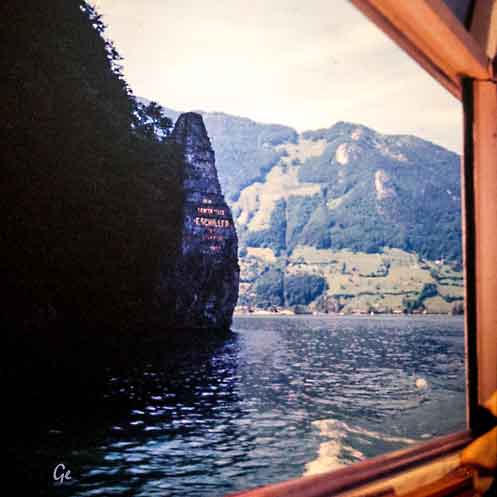
Schiller-Denkmal, Vierwaldstättersjøen i Sveits
Der Schillerstein, auch unter dem Namen Mythenstein
bekannt, ist ein etwa 20 Meter hoher, markanter
Felsblock, der am Eingang zum Urnersee, dem südlichsten
Becken des Vierwaldstättersees, aus dem Wasser ragt.
Er liegt gegenüber von Brunnen zwischen der Treib und dem Rütli und ist nur vom Wasser her zugänglich.
https://de.wikipedia.org/wiki/Schillerstein_(Vierwaldst%C3%A4ttersee)
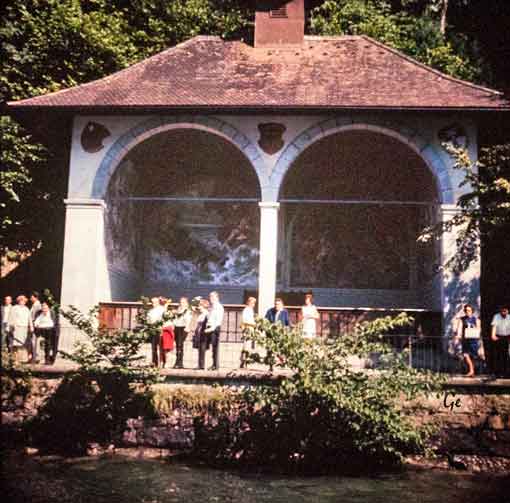
Tell-kapellet ved Veirwaldstättersjøen
http://history-switzerland.geschichte-schweiz.ch/william-
tell-switzerland-hero.html
Local tradition says that a first chapel had been constructed in
1388 at the place where William Tell is said to have escaped
from boat of the bailiff Gessler. The oldest documents mentioning
a chapel there date back to 1516/1530, however.
Tell's chapel became a place of pilgrimage from the 16th century on.
The current chapel was constructed in 1879.
Four frescos by Ernst Stückelberger of Basle show the scenes of
the legend:
- The bailiff Gessler forces William Tell to shoot an apple off his son's head with his crossbow.
- William Tell escapes from the boat of the bailiff Gessler during a storm on Lake Lucerne.
- William Tell shooting the tyrant Gessler.
- The oath of the Swiss confederates on the Rütli
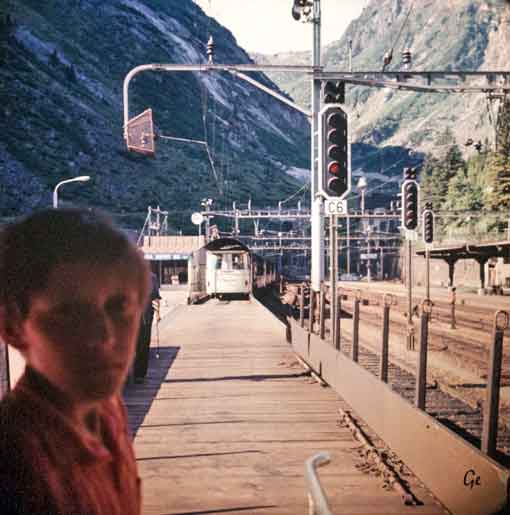
Buss og passasjerer måtte på tog gjennom St. Gotthardtunnellen.
Stasjonen er Göschenen.
Vi var fortsatt i Sveits da vi kom ut av tunnellen,
men vi hadde en veldig følelse av å ha kommet til Italia.
Det var italiensk stil på husa, og språket var italiensk.
The Gotthard railway (German: Gotthardbahn;
Italian: Ferrovia del Gottardo) is the Swiss trans-alpine
railway line from northern Switzerland to the canton of
Ticino. The line forms a major part of an important
international railway link between northern and
southern Europe, especially on the
Rotterdam-Basel-Genoa corridor.
The Gotthard Railway Company
(German: Gotthardbahn-Gesellschaft) was the former
private railway company which financed the
construction of, and originally operated, that line.
https://en.wikipedia.org/wiki/Gotthard_railway
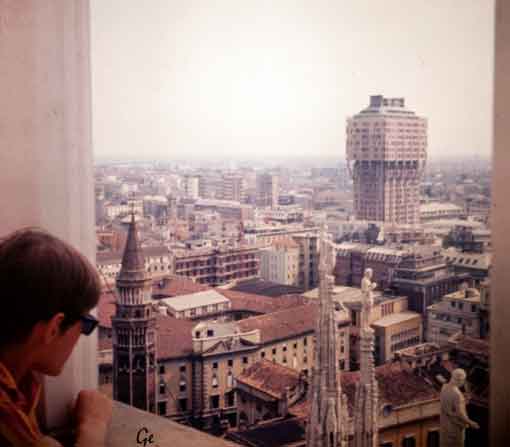
Utsikt fra Katedralen i Milano
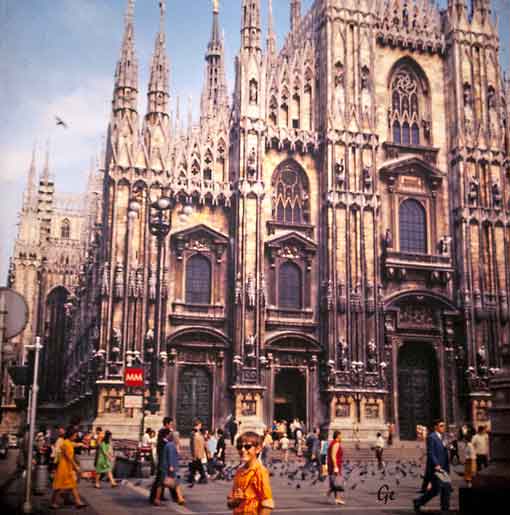
Katedralen i Milano
The Cathedral - Duomo di Milano OFFICIAL SITE (duomomilano.it)
(17. juni 2022)
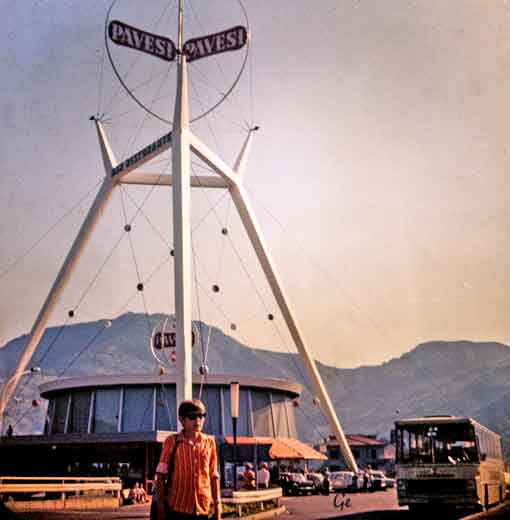
En Pavesirestaurent med utsikt til Appeninene
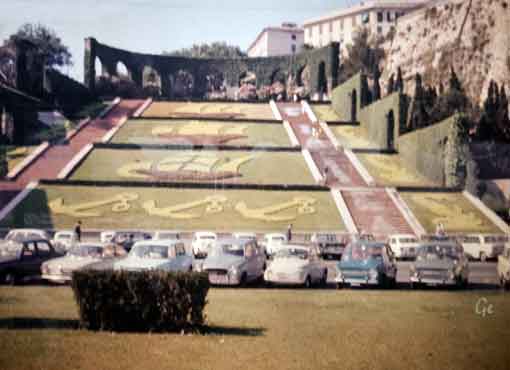
Genova med minnepark for Columbus
Columbus's caravels are drawn in flowers at a formal garden.
Christopher Columbus (Italian: Cristoforo Colombo;
c. 1451 – 20 May 1506) was an Italian explorer, navigator, and
colonizer. A citizen of the Republic of Genoa, under the auspices
of the Catholic Monarchs of Spain he completed four voyages across
the Atlantic Ocean. Those voyages and his efforts to establish
permanent settlements on the island of Hispaniola initiated the
European colonization of the New World.
https://en.wikipedia.org/wiki/Christopher_Columbus
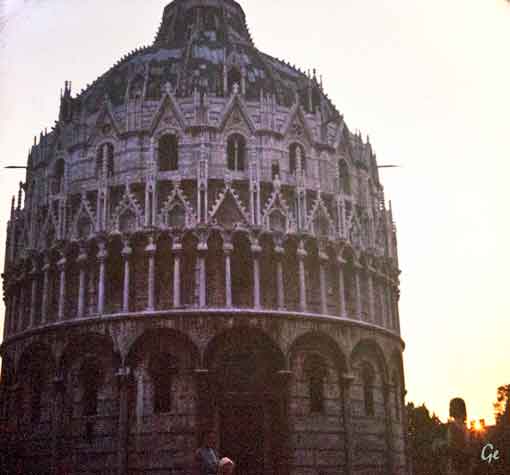
Baptisteriet i Pisa
The Pisa Baptistery of St. John (Italian: Battistero di San Giovanni)
is a Roman Catholic ecclesiastical building in Pisa, Italy. Construction started in 1152 to replace an older baptistery, and when it was
completed in 1363, it became the second building, in chronological
order, in the Piazza dei Miracoli, near the Duomo di Pisa and the cathedral's free-standing campanile, the famous Leaning Tower of
Pisa. The baptistery was designed by Diotisalvi, whose signature can
be read on two pillars inside the building, with the date 1153.
Pisa Baptistery - Wikipedia (17. juni 2022)
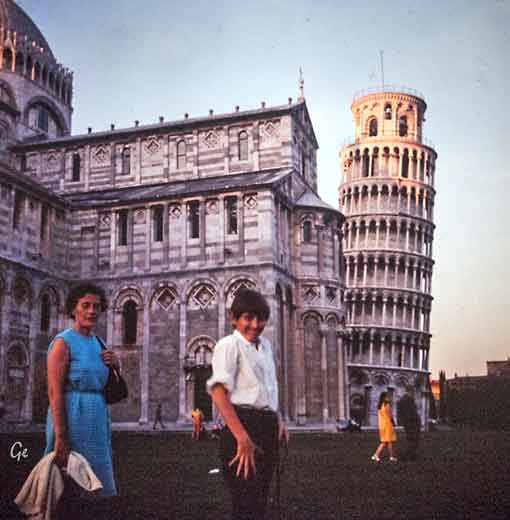
Katedralen og det Skjeve Tårn i Pisa
The Leaning Tower of Pisa is one of the most remarkable architectural structures from medieval Europe.
It is located in the Italian town of Pisa, one of the most visited European cities.
Leaning Tower of Pisa Facts:
- Tower of Pisa stands at 60 metres and until 1990 was leaning at about a 10 degree angle.
- Although it was designed to be perfectly vertical, it started to lean during construction.
- » Here you can see more Facts about Leaning Tower of Pisa.
- Leaning Tower
of Pisa, Italy: Guide to the Tower of Pisa
(17. juni 2022)
Pisa Cathedral (Italian: Cattedrale Metropolitana Primaziale di
Santa Maria Assunta; Duomo di Pisa) is a medieval Roman Catholic cathedral dedicated to the Assumption of the Virgin Mary,
in the Piazza dei Miracoli in Pisa, Italy, the oldest of the three
structures in the plaza followed by the Pisa Baptistry and the Campanile known as the Leaning Tower of Pisa. The cathedral
is a notable example of Romanesque architecture, in particular the
style known as Pisan Romanesque. Consecrated in 1118, it is the
seat of the Archbishop of Pisa. Construction began in 1063 and
was completed in 1092. Additional enlargements and a new facade were built in the 12th century and the roof was r
eplaced after damage from a fire in 1595.
Pisa Cathedral - Wikipedia (17. juni 2022)
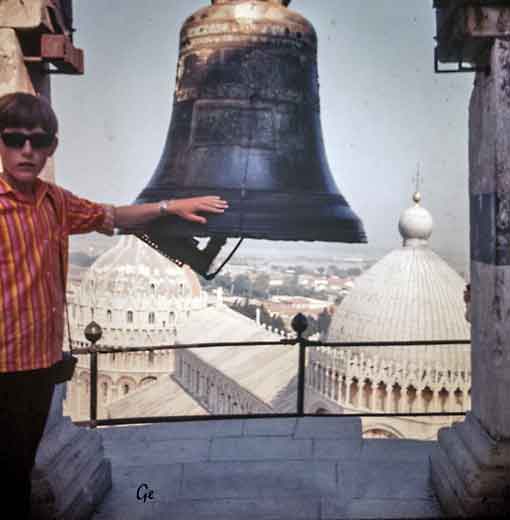
Jan Erik øverst i Det skjeve Tårn
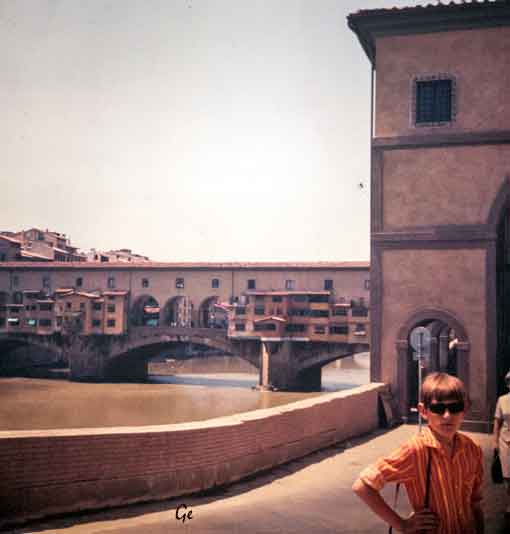
Firenze med Ponte Vecchio
Built very close to the Roman crossing, the Ponte Vecchio, or
Old Bridge, was the only bridge across the Arno in Florence
until 1218. The current bridge was rebuilt after a flood in 1345.
During World War II it was the only bridge across the Arno that
the fleeing Germans did not destroy.
Instead they blocked access by demolishing the medieval
buildings on each side. On November 4, 1966, the bridge
miraculously withstood the tremendous weight of water and silt
when the Arno once again burst its banks.
https://www.visitflorence.com/florence-monuments/ponte-vecchio.html
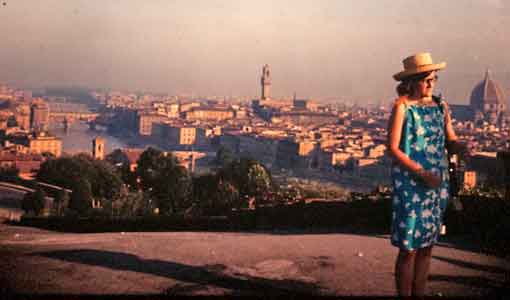
Grete med utsikt over Firenze
The 1966 flood of the Arno (Italian: Alluvione di Firenze del
4 novembre 1966) in Florence killed 101 people and damaged
or destroyed millions of masterpieces of art and rare books.
It is considered the worst flood in the city's history since 1557.
With the combined effort of Italian and foreign volunteers alike,
or angeli del fango ("Mud Angels"), many of these fine works
have been restored. New methods in conservation were devised and restoration laboratories established. However, even decades
later, much work remains to be done.
https://en.wikipedia.org/wiki/1966_flood_of_the_Arno
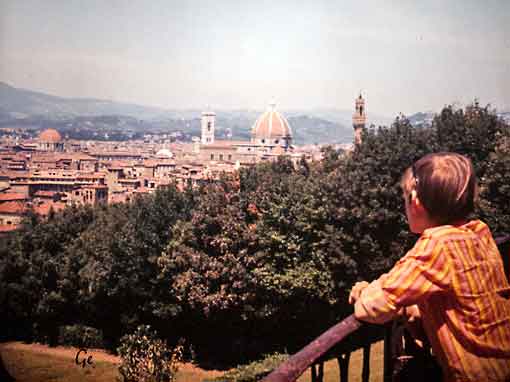
Jan Erik er i parken til Palazzio Pitti og har fin utsikt over Firenze.
More than a garden, more than just a “green lung” in Florence,
the Boboli gardens are one of the greatest open-air museums in
Florence that embraces another site of culture in Florence,
the Pitti Palace.
https://www.visitflorence.com/florence-museums/boboli-gardens.html
På grunn av flommen i 1966 var mange av de kjente
bygningene i byen stengt, så det var ikke så mye vi fikk se.
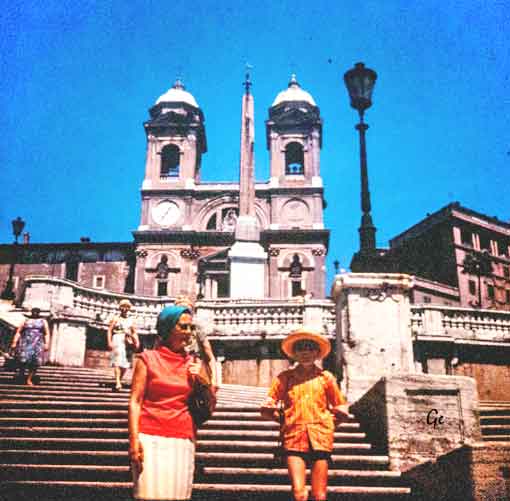
Så er vi kommet til Roma. Her i den Spanske Trappa
The Spanish Steps consist of 138 steps, which rise up a steep
slope connecting the Piazza di Spagna at the base with the
Piazza Trinità dei Monti and the Trinità dei Monti church at
the top. It’s a beautiful view from the bottom and from the top.
The steps were built during 1723 – 1725 following a
competition to design them in 1717 - which was won by an
architect named Francesco de Sanctis. A French diplomat
Francesco Di Sanctis financed them. They are a unique design
involving a mix of curves, straight flights, terraces and vistas.
http://tours-italy.com/blog/spanish-steps-rome-why-they-are-so-well-known/
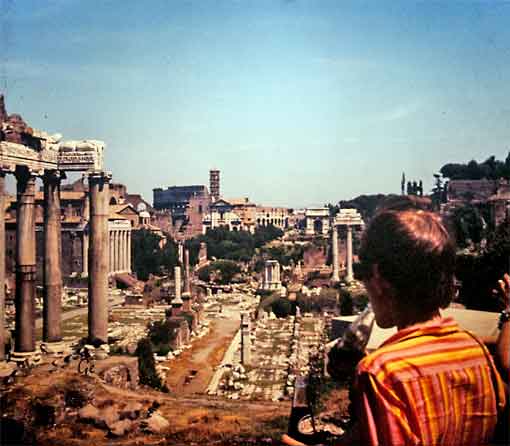
Jan Erik ser ut over Forum Romanum
The Roman Forum (Latin: Forum Romanum; Italian: Foro Romano)
is a rectangular forum (plaza) surrounded by the ruins of several important ancient government buildings at the center of the city of Rome. Citizens of the ancient city referred to this space,
originally a marketplace, as the Forum Magnum, or simply the
Forum.
It was for centuries the center of Roman public life: the site
of triumphal processions and elections; the venue for public speeches, criminal trials, and gladiatorial matches; and the nucleus
of commercial affairs. Here statues and monuments
commemorated the city's great men. The teeming heart of ancient Rome, it has been called the most celebrated meeting place in the world, and in all history. Located in the small valley between the Palatine and Capitoline Hills, the Forum today is a sprawling
ruin of architectural fragments and intermittent archaeological excavations attracting 4.5 million sightseers yearly.
https://en.wikipedia.org/wiki/Roman_Foru
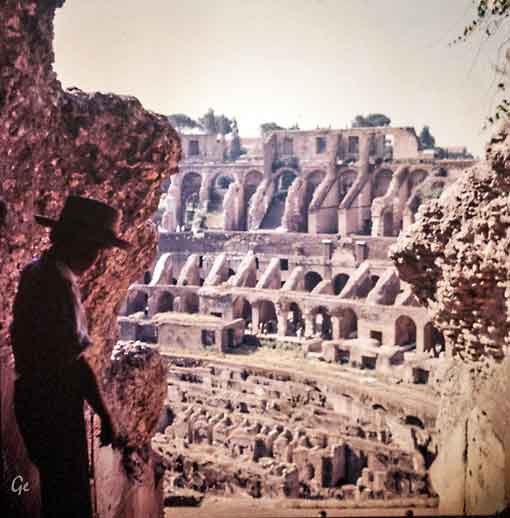
Colosseum var mer imponerende enn vi hadde trodd.
Located just east of the Roman Forum, the massive stone
amphitheater known as the Colosseum was commissioned
around A.D. 70-72 by Emperor Vespasian of the Flavian
dynasty as a gift to the Roman people.
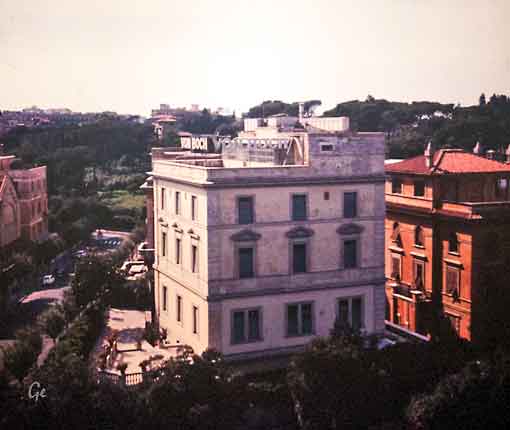
Utsikt fra hotellrommet vårt i Roma
In A.D. 80, Vespasian’s son Titus opened the Colosseum–
officially known as the Flavian Amphitheater–with 100
days of games, including gladiatorial combats and wild
animal fights. After four centuries of active use, the
magnificent arena fell into neglect, and up until the 18th
century it was used as a source of building materials.
http://www.history.com/topics/ancient-history/colosseum
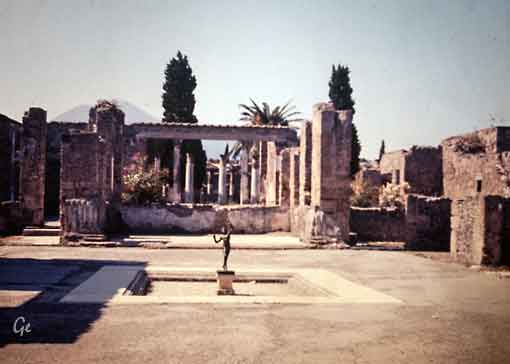
Pompeii med Vesuv i bakgrunnen.
På veien til Pompeii var vi innom Napoli.
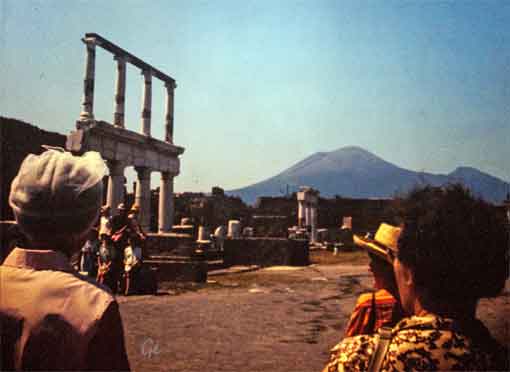
Også Pompeii og Vesuv
Verden går under i Pompeii
Det første varselet kom i de tidlige morgentimene
24. august år 79. Noen innbyggere i havnebyen Pompeii
våknet av at husene deres plutselig begynte å riste.
Enda et lite jordskjelv hadde rammet den store handelsbyen
ved Napoli-bukta på vestkysten av Italia. Men de fleste av
byens vel 20 000 borgere enset ikke ristingen, og sov
bare videre.
Sultne byborgere i Pompeii skulle akkurat til å sette seg
til lunsjbordet da hele deres verden med ett gikk under.
Et øredøvende brak fikk bakken til å skjelve, og selv de
største bygningene i Pompeii begynte å svaie faretruende.
I neste øyeblikk kunne byens forferdede innbyggere se en
enorm søyle av aske og pimpstein bli pumpet ut av fjellet
Vesuv omtrent ti kilometer mot nord.
Sakte, men sikkert forsvant dagslyset. Aske, pimpstein og
store steinblokker begynte å hagle over både husene og
de skrekkslagne innbyggerne i Pompeii.
Dommedag var begynt.
Mer her: http://historienet.no/sivilisasjoner/romerriket/
vesuv-forvandlet-pompeii-til-helvetets-forgard
fastlandet, og er en typisk kjeglevulkan (stratovulkan), bygd
opp av vekslende lava og askelag. Vulkanfjellet består av en
nordre halvsirkelformet rest av en eldre vulkan, Monte Somma
(fra før 79 e.Kr.) og en yngre vulkankjegle sønnenfor, som ved
hvert større utbrudd har forandret form og høyde. Krateret har
steile vegger og en grusfylt bunn.
Foten av vulkanen er tett befolket og utbruddene har derfor
voldt store ødeleggelser. I de nedre deler av vulkanens skråninger
dyrkes det store mengder vindruer, frukt og grønnsaker i den næringsrike vulkanske jorden. Lenger oppe finnes skogholt av eik
og valnøtt.
Etter et utbrudd i 1906 ble det plantet mye ny skog for å beskytte
mot de store skred av aske som ofte følger etter utbruddene,
særlig i kombinasjon med store nedbørmengder.
Det mest berømte utbruddet var i 79 e.Kr., da Pompeii og
Herculaneum ble begravd, den første i aske, den andre under
slamstrømmer. Etter et stort utbrudd 1631 hvor 3000 mennesker
omkom, har det jevnlig vært utbrudd av vekslende karakter,
særlig kraftige var de 1872 og 1906.
Utbruddet som begynte 1932, varte egentlig til mars 1944, da virksomheten igjen ble voldsom med eksplosjoner, innstyrtning
i krateret og utstrømming av lava. Dette foregikk omtrent
samtidig med alliert landgang i samme område.
Den berømte taubanen (omhandlet i sangen Funiculì-funiculà)
ble ødelagt av lavastrøm og en ny taubane bringer nå turister
opp til kanten av 1944-krateret. Det ligger et vulkanologisk observatorium på skråningen av Vesuv.
https://snl.no/Vesuv
Luxuriant, extraordinary, and such a mild climate.
Capri is a Mediterranean island of calcareous origin that has
been visited over the centuries by intellectuals, artists and
writers, all enthralled by its magical beauty.
nature, worldliness, culture and events that daily blend
together and bring the Legend of Capri to life; a legend
that sees no comparison anywhere in the world.
http://www.capritourism.com/en/index
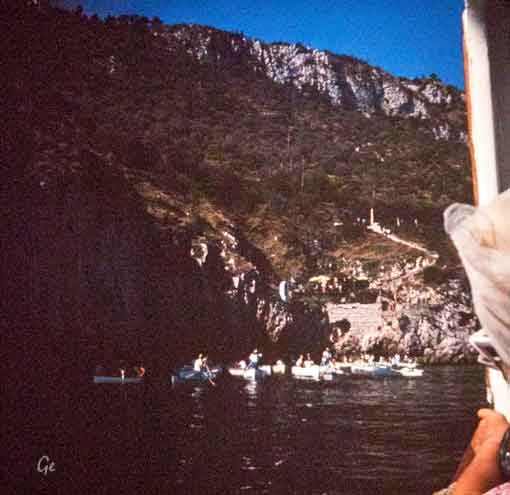
Capri, utenfor den Blå Grotte. Bare robåter kommer inn i grotta.
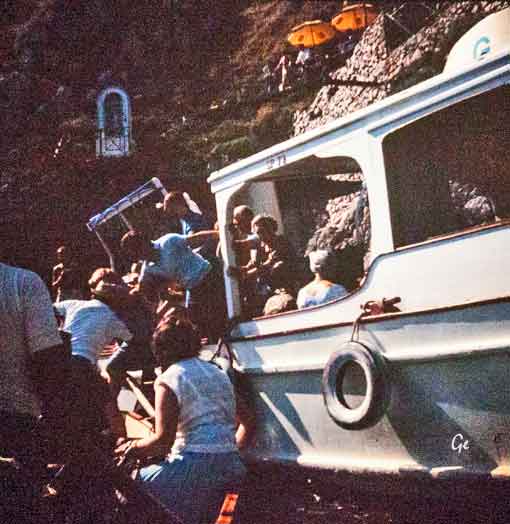
Etter å ha vært i grotta går vi tilbake til den litt større båten.

Bilde fra: http://www.capri.it/it/s/la-grotta-azzurra-2
Hop aboard a wooden rowboat, lay back, and let yourself be
carried through a tiny stone portal to another world by your
able skipper, who navigates seamlessly under the meter-high
cave mouth. Inside, pass from complete darkness into a
sparkling cavern, lit by azure blue light, while the sounds of
ancient Neapolitan song echo along the stone walls.
You are in the Blue Grotto.
Less than floating on water, you feel as if you
are suspended in the heavens. At least once in your lifetime,
you should experience this marvel of nature and see firsthand
why the Grotta Azzura is the most famous sight on Capri island.
http://www.capri.com/en/s/la-grotta-azzurra
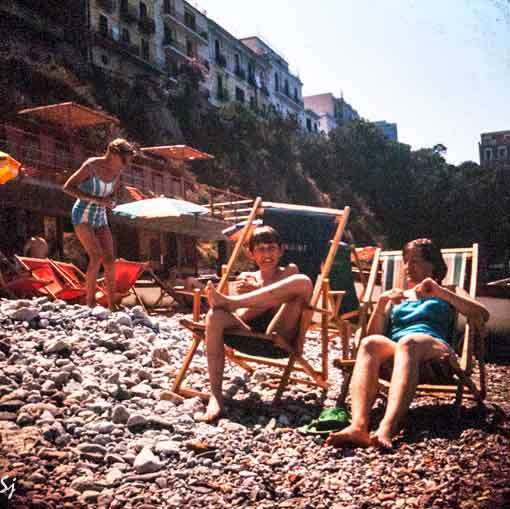
Stranda var ikke av de beste, men godt å slappe litt av i sola.
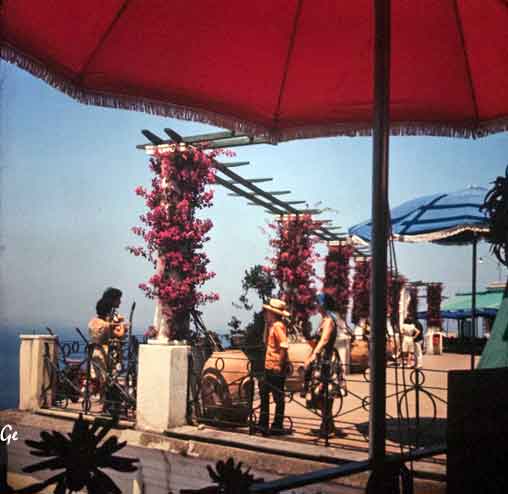
Monte Solare på Capri
Monte Solaro is a mountain on the island of Capri in Campania,
Italy. With an elevation of 589 m, its peak is the highest point
of Capri.
https://en.wikipedia.org/wiki/Monte_Solaro
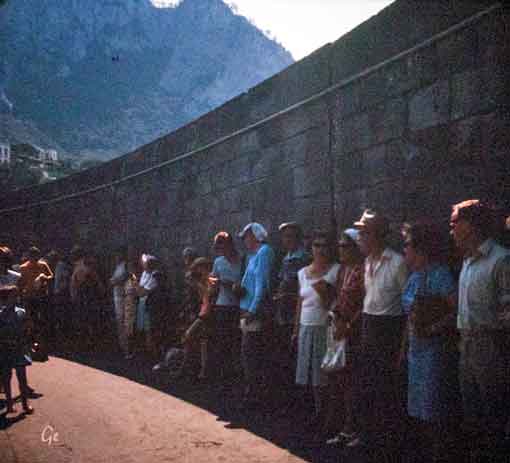
En veldig varm dag. Mens vi venter på båten tilbake til Sorrento,
vil de fleste stå i skyggen.
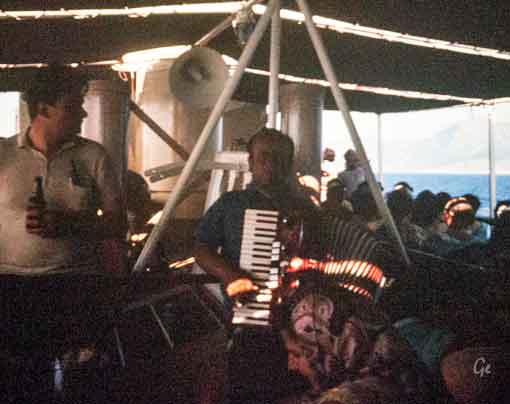
God stemning på båten til Sorrento.
Han med øl-flaska er reiselederen vår.
En fantastisk flink og hyggelig reiseleder.
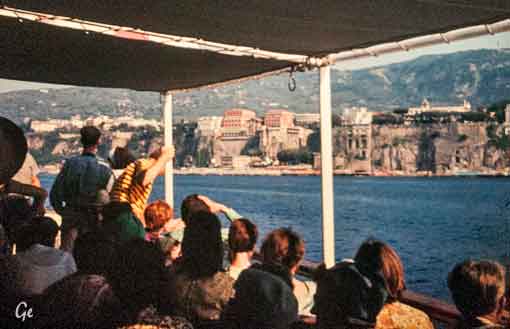
Vi nærmer oss Sorrento
Facing north over the Bay of Naples, Sorrento is situated towards
the end of the mountainous Sorrentine peninsula, over the hills
from the famous resorts of the Amalfi Coast.
In mythology, this area is often identified as the land of the sirens, beautiful maidens of the sea whose song lured mariners to their
doom. Sorrento is built on a historic site settled from prehistoric
times onwards; there was a Greek town here, and then the Roman
town of Sorrentum.
http://www.italyheaven.co.uk/campania/sorrento.html
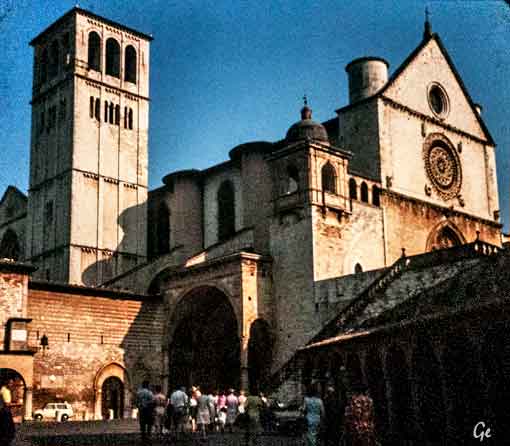
Fra Sorrento reiste vi via Roma til Ravenna.
På veien var vi innom Assisi.
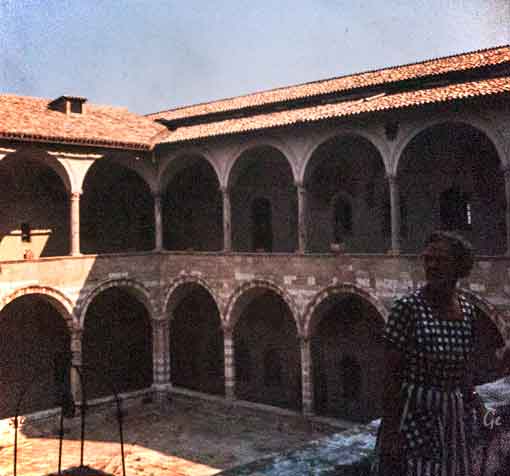
Klosteret i Assisi
Saint Francis, closely associated with the work of the
Franciscan Order. Its medieval art masterpieces, such as the
Basilica of San Francesco and paintings by Cimabue, Pietro
Lorenzetti, Simone Martini and Giotto, have made Assisi a
fundamental reference point for the development of Italian
and European art and architecture.
http://whc.unesco.org/en/list/990
Frans fra Assisi, en av den katolske kirkes mest berømte helgener, Fransiskanerordenens stifter.
Han var sønn av en rik kjøpmann, Pietro Bernardone, i Assisi
i Umbria. Hans døpenavn var Giovanni, men faren gav ham
tilnavnet Francesco, visstnok på grunn av sin sympati for
Frankrike.
Etter et muntert ungdomsliv opplevde han i 1206 et religiøst
gjennombrudd under en alvorlig sykdom. Han brøt med sitt
gamle liv og sine gamle venner og ofret seg for å pleie fattige
og syke, især spedalske, som han tidligere hadde følt en særlig
avsky for.
Han ble forstøtt av faren og levde et par år som eneboer,
blant annet opptatt av å gjenreise forfalne kirkebygninger,
deriblant sin yndlingskirke i San Damiano, litt utenfor Assisi.
https://snl.no/Frans_fra_Assisi
Prayer
Lord, make me an instrument of Your peace.
Where there is hatred, let me sow love;
where there is injury, pardon;
where there is doubt, faith;
where there is despair, hope;
where there is darkness, light;
where there is sadness, joy.
O, Divine Master, grant that I may not so much seek to be
consoled as to console;
to be understood as to understand;
to be loved as to love;
For it is in giving that we receive;
it is in pardoning that we are pardoned;
it is in dying that we are born again to eternal life.
http://www.catholic.org/prayers/prayer.php?p=134
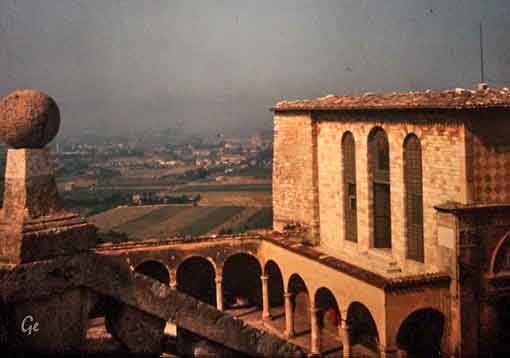
Assisi
Etter Assissi kom vi til Ravenna. Der overnatta vi.
Neste morgen så vi mosaikker .
Ravenna was the capital city of the Western Roman Empire
from 402 until that empire collapsed in 476. It then served as the
capital of the Ostrogothic Kingdom until it was re-conquered in
540 by the Byzantine Empire. Afterwards, the city formed the
centre of the Byzantine Exarchate of Ravenna until the invasion
of the Lombards in 751, after which it became the seat of the
Kingdom of the Lombards.
Although it is an inland city, Ravenna is connected to the
Adriatic Sea by the Candiano Canal. It is known for its
well-preserved late Roman and Byzantine architecture, with
eight buildings comprising the UNESCO World Heritage Site
"Early Christian Monuments of Ravenna".
https://en.wikipedia.org/wiki/Ravenna (1.9.2019)
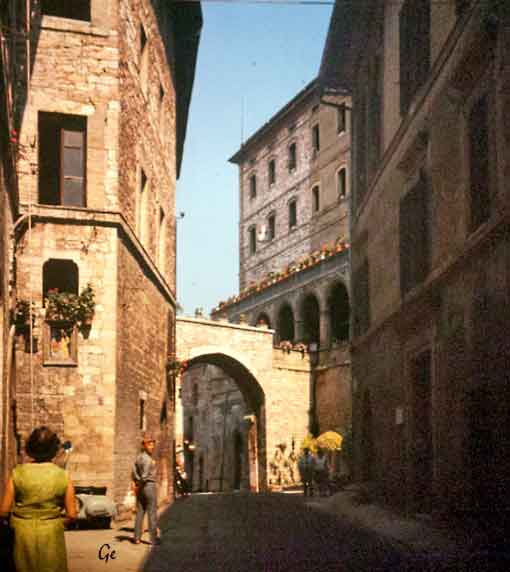
Gate i Assisi
Fra Ravenna kjørte vi langs strendene med Rimini og de andre
kjente badestedene, men var ikke innom noen av dem.
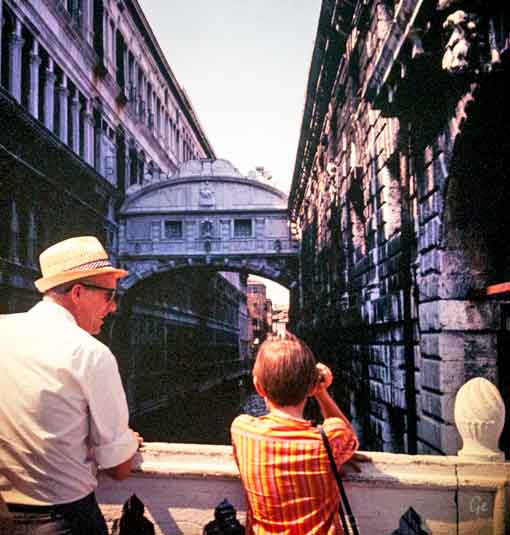
Venezia med Sukkenes Bro
Sukkenes bro, it. Ponte dei Sospiri, lukket buebro over en av
kanalene i Venezia, fører fra Dogepalasset til dogenes gamle
fengsel, bygd 1597. Markerer overgangen fra den frie borgers
rettssal til frihetsberøvelse på den andre siden, idet fangene
ble ledet over Sukkenes bro etter domfellelsen.
Navnet er også brukt andre steder om inngangen til fengsler.
https://snl.no/Sukkenes_bro
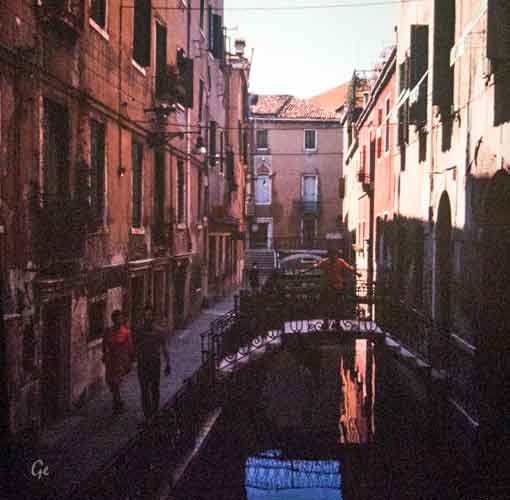
Hotellet vårt lå i et rolig området ved denne smale kanalen.
Under:
De andre plassene i Venezia må nøye seg med å bli kalt
campo eller lignende.
Piazettaen er den litt mindre plassen foran Dogepalasset.
Mens Marcusplassen altså er byens eneste "piazza".
Der duene konkurrerer med tre forførende salongorkestre
om folks oppmerksomhet.
https://www.nrk.no/kultur/marcusplassen-i-venezia-1.3715252
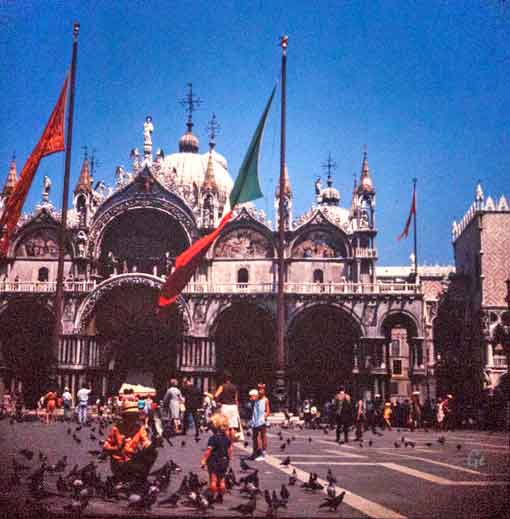
Marcus-kirken og Marcus-plassen
Markuskirken (It: Basilica di San Marco in Venezia) er den best
kjente av kirkene i Venezia. Den ligger ved Markusplassen, ved
siden av Dogepalasset, og er et av Venezias kjennemerker.
Kirken er et godt eksempel på bysantinsk arkitektur.
Siden 1807 har den vært sete for patriarkatet i Venezia.
Kjøpmenn fra Venezia hadde anskaffet relikvier man antok kom
fra Markus. Som en del av Dogepalasset ble det anlagt en
midlertidig kirke i 828. Det var den første Markuskirken. Den ble i 832 erstattet av en ny kirke på stedet hvor dagens kirke står.
I 976 brant den under et opprør. I 978 ble den gjenreist, og igjen
i 1063. Den siste danner basis for dagens basilika.
https://no.wikipedia.org/wiki/Markuskirken
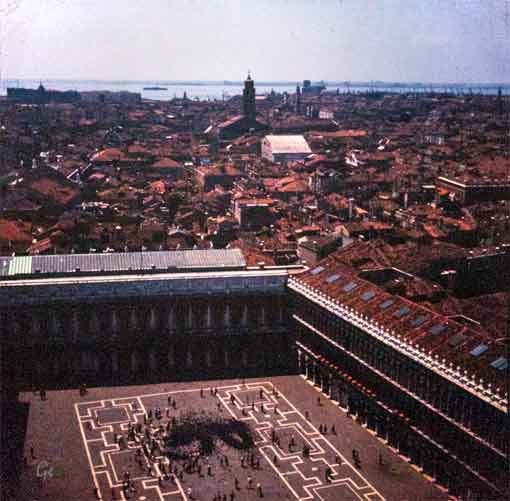
Duene mates. Foringen er sponses av forsikringsselskapet AG.
Bildet er tatt fra Campanilen
Campamile og loggia
I hjørnet mellom Marcuskatedralen og loggiaen som vender
mot Dogepalasset og Piazettaen, står det høye klokketårnet
fra 1100-tallet med påbygg i renessanse.
Litt i veien, vil mange si.
Men med sin høyde kronet av en forgylte engel, hadde den
også en funksjon som fyrtårn.
https://www.nrk.no/kultur/marcusplassen-i-venezia-1.3715252
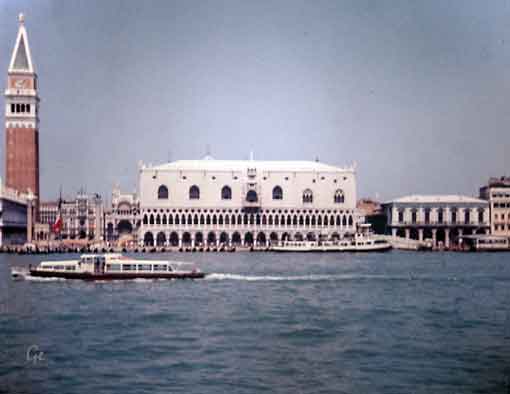
Det ble tid til en tur til Venezias Lido.
Dessverre på den eneste litt kjølige dagen vi hadde på turen.
Bilder er tatt fra båten til Lido.
Vi se Dogepalasset, campanilen og klokketårnet
Dogepalasset (It: Palazzo Ducale) er et av de mange
kjennemerkene i Venezia. Bygget fungerte som regjeringsbygg
og rettslokale.
Det var også bolig for Dogen.
Det er et av de vesentligste profane gotiske bygg.
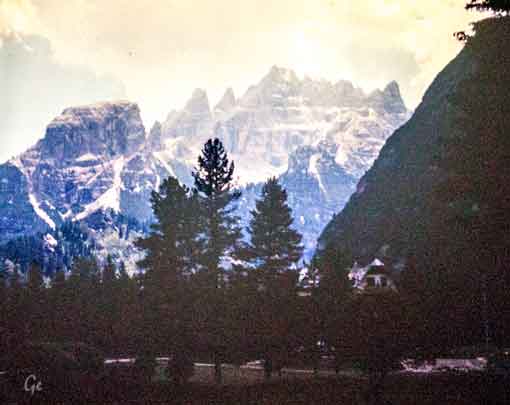
Dolomittene ved Carbonin
Palasset ligger som nærmeste nabo til Markuskirken ved Markusplassen.
Bak palasset fører en av Venezias mest kjente broer –
Sukkenes bro – til fengselet. Mot sørd vender palasset
ut mot Canal Grande, bare adskilt av et bredt fortorv.
https://no.wikipedia.org/wiki/Dogepalasset
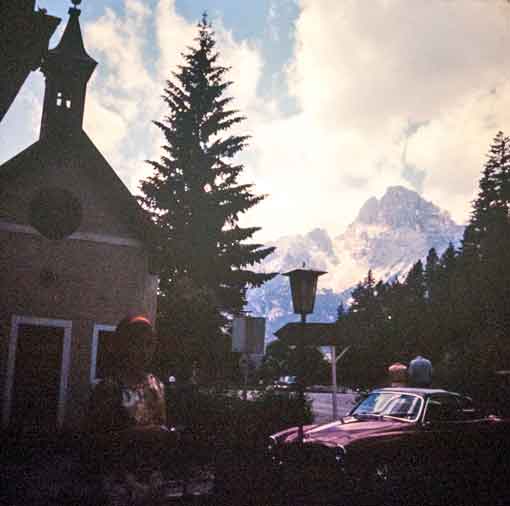
Dolomittene ved Carbonin
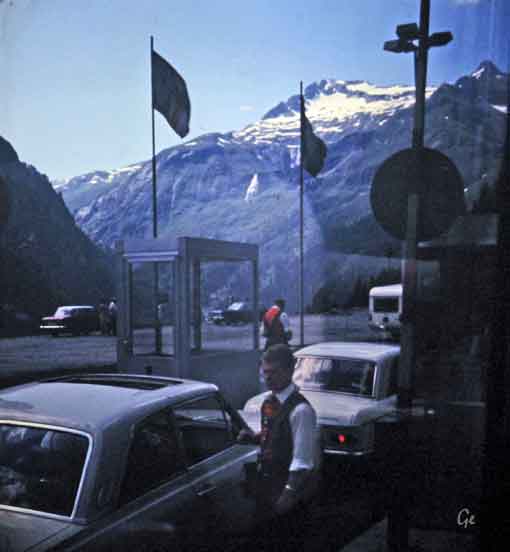
Inngangen til Gross-Glockner-tunnellen
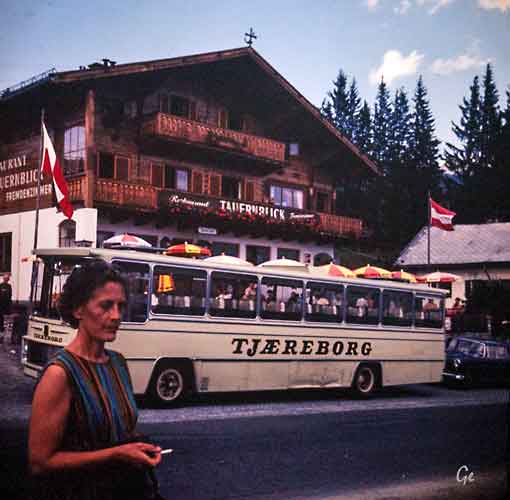
Tauernblick. Bussen har fått noen skraper.
Synd, det var en helt ny buss.
The Grossglockner High Alpine Road (in German
Großglockner-Hochalpenstraße) is the highest
surfaced mountain pass road in Austria.
It connects Bruck in the state of Salzburg with Heiligenblut in Carinthia via
Fuscher Törl and Hochtor Pass at 2,504 m (8,215 ft).
The road is named after the Grossglockner,
Austria's highest mountain.
Built as a scenic route, a toll is assessed for passage.
https://en.wikipedia.org/wiki/Grossglockner_High_Alpine_Road
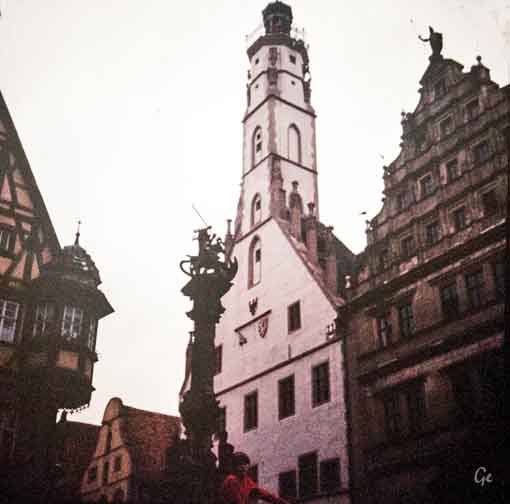
Rothenburg ob der Tauber
Marktplatz
This is the pulsating heart of the town.
This is where it all happens, from the weekly market to guided
tours, the historic shepherd’s dance, the fireworks as part of
the town festival or performances by the Ambassadors of Music.
https://tourismus.rothenburg.de/index.php?id=610
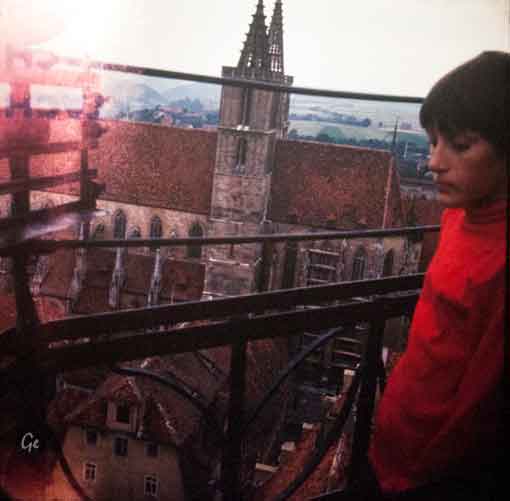
St. James Church
St. James (German: St. Jakob) is a Lutheran (originally Catholic)
church in Rothenburg ob der Tauber, Germany, which serves as a church on the pilgrimage route to St. James Church in Santiago de Compostela, Spain. It has two towers (south tower: 55.2 m, 57.7 m north tower). The church was built between 1311-1484
St. James's Church, Rothenburg ob der Tauber - Wikipedia (17. juni 2022)
region of Bavaria, Germany. It is well known for its
well-preserved medieval old town, a destination for tourists from
around the world. It is part of the popular Romantic Road through southern Germany. Today it is one of only three towns in Germany
that still have completely intact city walls, the other two being Nördlingen and Dinkelsbühl.
Rothenburg was a Free imperial city from the late Middle Ages to
1803. In 1884 Johann Friedrich (von) Hessing (1838–1918) built Wildbad Rothenburg o.d.T. 1884–1903.
the 1st-century A.D.
In 950, the weir system in today's castle garden was
constructed by the Count of Comburg-Rothenburg.
In 1070, the counts of Comburg-Rothenburg, who also owned
the village of Gebsattel, built Rothenburg castle on the
mountain top high above the River Tauber.
Rothenburg ob der Tauber - Wikipedia (17. juni 2022)
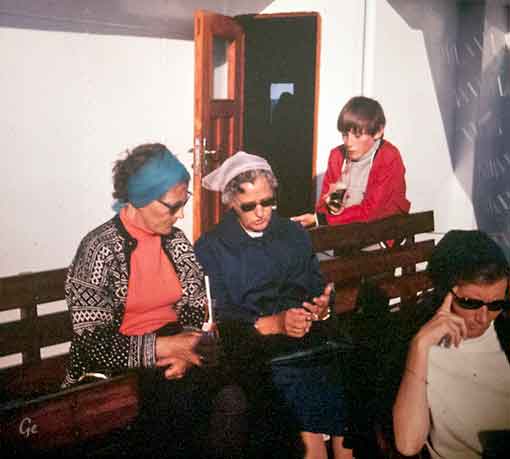
Tilbake til Oslo med Holger Danske
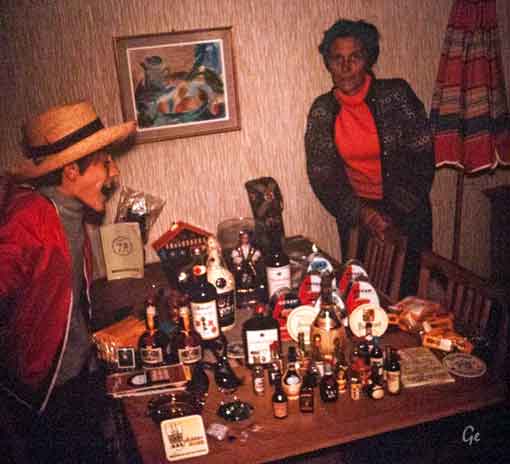
Det ble litt handling underveis